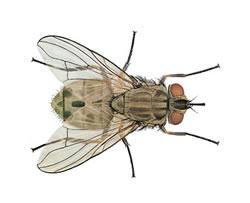
Stable Fly Control
If you have an active stable fly infestation, follow these guidelines to learn how to get rid of stable flies, and the best products for stable fly treatment.
Identification of the Stable Fly
Size: About 1/4 inch long
Color: They have 4 dark stripes on the upper body, with dark spots on the abdomen. They have checkerboard markings on the topside of the abdomen.
Stable Flies are sometimes confused with House Flies. The Stable Fly is easily distinguished from other common domestic flies by the long, pointed proboscis which extends in front of the head.
Both males and females use this proboscis (stiff and needle-like) to pierce the skin of a host and suck their blood. The bite is painful enough to disrupt outdoor activities such as picnics when stable flies are numerous.

Stable flies, also known as "biting flies," can deliver a painful bite. They bite people, livestock, pets, and other mammals. The bites may feel like a needle stab and typically occur around the ankles and lower parts of the legs. Stable flies are very persistent when searching for a blood meal. They require a blood meal for reproduction. Stable flies overwinter in breeding sites and emerge the following spring as adults.
Stable Fly Control and Elimination
- Stable flies are commonly found near stables but also along the seashore and near dog kennels.
- Stable flies prefer to feed outside and are rarely found feeding or resting indoors.
- Since Stable Flies breed in livestock waste, removing the breeding source is the best method to eliminate them. Remove other breeding areas like wet straw and mulch and all rotting organic matter.
Biology and Habits of Stable Flies
Stable fly eggs are laid in decaying hay, straw, fermenting weeds, grass, and seaweed. Compost piles, chicken manure, wet hay bales, grass clippings, and urine-soaked straw are prime locations for the stable fly eggs.
The eggs of Stable flies hatch after 1 to 3 days into yellowish-white maggots/larvae. These larvae pass through 3 instars and pupate in the last larval skin.
In warm weather, the pupal stage lasts 6 to 20 days. The average adult lives for about 20 days.
The early morning and late afternoon hours are commonly peak feeding times. Peak activity usually occurs during warm periods following rainfall.
Stable flies like to feed on the lower parts of the hosts, such as horses and cattle's legs and belly. Cattle, horses, and people are typically bitten on the legs while dogs and swine are bitten on the ears.
Even though the female requires a blood meal to lay eggs, both males and females feed on blood. They can often bite through clothing.
About 60 - 120 eggs are laid at a time, with some flies surviving to lay two or more eggs batches. Eggs hatch in less than 24 hours to produce larvae. The larvae feed and grow beneath the surface of the breeding material.
How To Prevent Stable Flies

Stable Flies are blood feeders; about the only prevention is to minimize places where stable flies lay eggs, such as:
-
Livestock waste
-
Soggy hay
-
Grasses
-
Piles of moist fermenting weeds
-
Grass cuttings
-
Soiled straw bedding
Stable Flies are part of the Biting/Nuisance Fly Category
Peterwchen, CC BY-SA 4.0
Written by our resident pest control expert Ken Martin.




